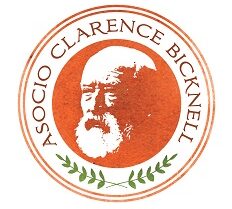An appreciation by Luca Barale
The more research is done on Clarence Bicknell, the more we find out about his achievements. We are so grateful to the experts who choose to do this research and it is fun to be able to help them where possible with images and source material. Luca Barale is a researcher at the National Research Council of Italy, Institute of Geosciences and Earth Resources, Via Valperga Caluso in Torino. It was a pleasure to meet Luca at the Chronos exhibition and talk in Genova on 20th Decvember 2023 and to get to know his work better. He has worked with us already in the past, for example on the origins of the naming of the Cima Bicknell over the Vallée des Merveilles; you can read that (https://clarencebicknell.com/naming-of-cima-pollini/) and other topcs from Luca on our Facebook page https://www.facebook.com/clarencebicknell and now on our website https://clarencebicknell.com/news-views/ and /documents.
He is also on https://scholar.google.com/citations?user=5NDy6tIAAAAJ&hl=en and https://www.researchgate.net/profile/Luca-Barale.
Here is a summary of this new paper on Clarence’s attributes as a geologist… e in italiano
Clarence Bicknell (1842-1918): botanist, archaeologist, Esperantist, and… citizen geologist.
Bicknell established relationships and maintained correspondence and collaboration with several scientists, including some geologists such as Alberto Pelloux (1868-1948), Federico Sacco (1864-1948), Arturo Issel (1842-1922), and Achille Tellini (1866-1938). Over the years, Bicknell had also put together an important collection of Pliocene fossils — mainly molluscs— from various outcrops in Western Liguria. Bicknell willingly shared these fossils with the palaeontologists Luigi Bellardi and Federico Sacco and donated a large part of them to the Geological Museum of Torino. To acknowledge Bicknell’s contribution to the study of Pliocene faunas of Western Liguria, two Pliocene mollusc species were dedicated to him: the bivalve Aequipecten bicknelli (Sacco, 1897) and the gastropod Epitonium bicknelli (Hornung, 1920).
Luca Barale’s paper was published in January 2024 in Rendiconti Online della Società Geologica Italiana, Vol 62 (2024). The definitive version is online on the journal’s website: https://doi.org/10.3301/ROL.2024.19. We have the auhtor’s approval to make available to you a “pre-print” version on which there are no restrictions. We publish this on the Clarence Bicknell website with pleasure.
Riassunto
Clarence Bicknell (1842-1918) fu un personaggio eclettico, naturalista, archeologo artista ed esperantista. Proveniente da un’agiata famiglia inglese, si spostò nel 1878 a Bordighera, nella Riviera Ligure di Ponente, dove passò il resto della sua vita e dove fondò il Museo Bicknell. Interessatosi dapprima allo studio della flora locale, si dedicò poi, dal 1897 fino alla sua morte, allo studio sistematico delle incisioni rupestri preistoriche delle valli delle Meraviglie e di Fontanalba, nelle Alpi Marittime. Bicknell strinse relazioni e durature amicizie con numerosi studiosi, tra i quali i geologi Alberto Pelloux (1868-1948), Federico Sacco (1864-1948), Arturo Issel (1842-1922), and Achille Tellini (1866-1938). Negli anni, Bicknell mise insieme una ricca collezione di fossili pliocenici raccolti in diverse località della Liguria di Ponente, e la mise a disposizione dei paleontologi Luigi Bellardi e Federico Sacco, donando moltissimi esemplari al Regio Museo Geologico di Torino. Per i suoi contributi allo studio delle faune plioceniche della Liguria occidentale, vennero dedicate a Bicknell due specie fossili: il bivalve Aequipecten bicknelli Sacco, 1897 e il gasteropode Epitonium bicknelli (Hornung, 1920).

